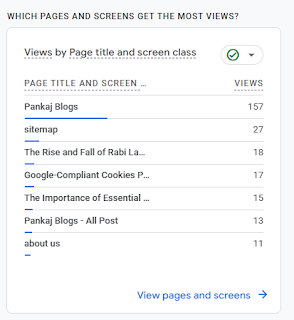How to Find Which Pages of Your Site Are Indexed by Google: 10 Proven Methods
Posted on April 4, 2025 by Pankaj
Ever wondered which pages of your website Google has tucked away in its massive index? Whether you’re a blogger, a business owner, or just curious, knowing what’s indexed can help you optimize your site, troubleshoot issues, or simply satisfy your curiosity. Today, I’m sharing 10 effective methods to list out the pages Google has indexed from your site—complete with visuals to guide you. Let’s dive in!
1. The Classic site: Search Trick
If you’ve ever typed site:yourdomain.com into Google, you’ve already stumbled upon one of the easiest ways to peek at indexed pages. This simple command shows all the pages Google knows about from your site. Add a keyword (like site:pankajblogs26.blogspot.com tech) to narrow it down. It’s quick, but Google caps results, so it’s not the full picture—perfect for a fast check, though!
2. Google Search Console: The Pages Report
For the real deal, head to Google Search Console (GSC). If you’ve verified your site, go to the “Pages” section under “Indexing.” Filter by “Indexed” to see a list of URLs Google has in its database. You can even export this list (up to 1,000 rows). It’s straight from the source—accurate and detailed. A must for serious site owners!
3. URL Inspection Tool in GSC
Want to check one specific page? GSC’s URL Inspection Tool is your friend. Pop in a URL, and it’ll tell you if it’s indexed, when it was last crawled, and more. It’s not for bulk checks, but it’s gold for verifying key pages like your homepage or latest post.
4. Compare Your Sitemap
If you’ve submitted a sitemap via GSC (and you should!), grab that list of URLs and compare it to what’s indexed. Use the Pages report or a site: search to spot gaps. This method ensures all your intended pages are getting noticed by Google—great for bigger blogs like mine!
 |
| Match your sitemap to indexed pages to find what’s missing. |
5. Third-Party SEO Tools
Tools like Screaming Frog, Arefs, or SEMrush can crawl your site and cross-check with Google’s index. Screaming Frog gives you a crawl list, while Arefs can show indexed status via GSC integration. These are powerhouse options for detailed audits—especially if you’re managing a growing site.
6. Google Analytics + GSC Combo
Link Google Analytics with GSC, then check the “Queries” or “Landing Pages” report. Pages driving organic traffic are almost certainly indexed. It won’t show everything (no-traffic pages get missed), but it’s a neat way to see what’s working.
 |
| See which indexed pages are bringing in visitors. |
7. Exact URL Search
For a manual spot-check, search site:https://yourdomain.com/page1 in Google. If it shows up, it’s indexed. Simple, but tedious for more than a handful of pages—use this when you’re laser-focused on a few URLs.
 |
A precise way to check one page at a time. |
8. Search Analytics for Sheets
Love spreadsheets? The “Search Analytics for Sheets” Google add-on pulls GSC data into a Google Sheet, including indexed URLs based on impressions or clicks. It bypasses GSC’s 1,000-row export limit—perfect for data nerds like me!
9. Google Search API (For the Techies)
If you’re handy with code, Google’s Custom Search JSON API lets you query site:yourdomain.com programmatically. It’s limited to 100 results per query, but you can loop it for more. API quotas apply, so it’s not free forever—ideal for automation fans.
10. Bing Webmaster Tools (A Bonus Peek)
Not Google, but Bing Webmaster Tools shows indexed pages for Bing’s engine. Since there’s overlap with Google, it’s a handy cross-reference. It won’t match perfectly, but it’s a free extra perspective.
Conclusion
No single method gives you everything—Google’s index is too vast, and its tools have limits. For quick checks, site: is your go-to. For precision, GSC is king. And for deep dives, third-party tools or scripts step up. Pick what fits your needs and keep checking—indexing changes fast!
Have a favorite method or a question? Drop a comment below—I’d love to hear from you! Until next time, happy blogging!



Comments
Post a Comment